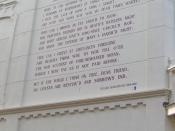Shakespearean sonnets contain three four-line stanzas which are called quatrains followed by a rhyming couplet. Shakespeare uses the first twelve lines to present a problem, idea, or situation and then resolves or emphasizes it in the final couplet. In Shakespeare's "Sonnet 87" he stays true to this form. In the first three quatrains the speaker presents the situation of having to bid farewell to the youth but clarifies it in the final couplet.
In the first three quatrains the speaker introduces the fact that he must say goodbye to the youth. In the first quatrain he uses legal terminology to propose how preposterous it is for the poet to think that he could possess the youth. The second and third quatrains contain the poet's reasons for his saying goodbye. In the second quatrain the speaker questions why he ever thought he deserved the youth, using lines such as, "For how do I hold thee but by thy granting?
And for that riches where is my deserving?" The poet realizes that their parting is the fault of both, because in the third quatrain he states, "Thyself thou gavest, thy own worth then not knowing, Or me, to whom thou gavest it, else mistaking."
Shakespeare stays true to his form when he uses the final couplet to clarify the first three quatrains. In the last two lines the speaker concedes that his friendship with the young man has collapsed. In the line, "Thus have I had thee as a dream doth flatter," he reveals that his relationship with the youth was only a fantasy of his.
Like all Shakespearean sonnets "Sonnet 87" contains three quatrains with a rhyming couplet at the end. In the first three quatrains the poet presented the situation of his bidding farewell to the...


